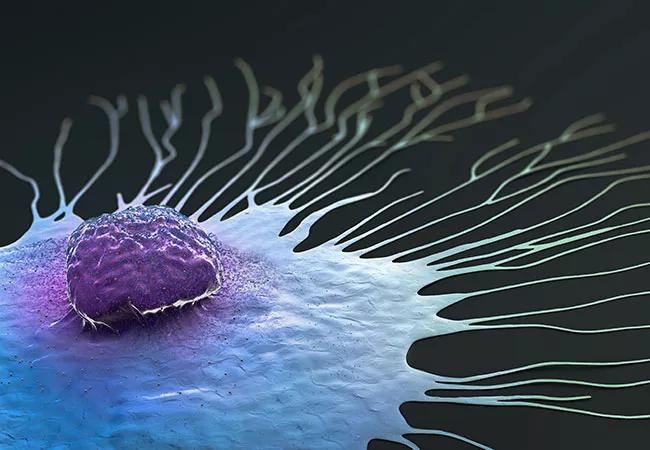Impressive progression-free survival observed in phase 2 study

An investigational third-generation selective estrogen receptor (ER) modulator, lasofoxifene, when combined with a cyclin-dependent kinase (CDK) 4/6 inhibitor, demonstrated promising clinical activity for the treatment of women with ER-positive/HER2-negative metastatic breast cancer who harbor an ESR1 mutation and whose disease had progressed on prior therapies.
Advertisement
Cleveland Clinic is a non-profit academic medical center. Advertising on our site helps support our mission. We do not endorse non-Cleveland Clinic products or services. Policy
“Lasofoxifene could therefore represent a future option for this subset of women for whom treatment options are limited,” says Halle C. F. Moore, MD, breast oncology specialist at Cleveland Clinic. As one of 16 centers involved, Cleveland Clinic contributed four of the 29 patients who were enrolled in the open label, single-arm, phase 2 study, known as ELAINE 2, which explored the lasofoxifene plus abemaciclib combination.
Preclinical data demonstrated activity of lasofoxifene in tumor cell lines with ESR1 mutations, with efficacy as monotherapy and in combination with a CDK4/6 inhibitor, according to results presented at the 2022 ASCO annual meeting. “The longer that breast cancer can be controlled on well-tolerated hormonal-based oral therapies, the better it will be for patients. The goal is to delay the time to require chemotherapy and hopefully improve survival outcomes down the road,” says Dr. Moore.
Once breast cancer has metastasized, resistance to treatment will typically develop, resulting in progression of the disease. “One of the common mechanisms of resistance to endocrine treatment for breast cancer is development of an ESR1 mutation, which can constitutively activate the ER and confers resistance to aromatase inhibitor therapy,” she says.
Patients enrolled had ER-positive/HER2-negative metastatic breast cancer and an acquired ESR1 mutation identified in circulating tumor (ct) DNA. Eligible participants had progressed on one or two lines of endocrine therapy for metastatic disease, and one line of prior chemotherapy was allowed. Patients received oral lasofoxifene daily and abemaciclib twice daily until progression, death, toxicity, or withdrawal.
Advertisement
Patients entered with a median of two lines of prior therapy in the metastatic setting. A total of 28 (96.6%) of patients had prior CKD4/6 inhibitor therapy, including four (13.8%) with prior abemaciclib, and 14 (48.3%) had prior chemotherapy in the metastatic setting.
The average time to disease progression was 13.9 months and the clinical benefit rate (CBR), defined as no progression by 24 weeks, was 69.0%. The progression-free survival achieved is nearly triple and the CBR nearly double that achieved with abemaciclib alone or abemaciclib combined with fulvestrant following progression on prior therapies.
Among the 18 patients with measurable target lesions, nine (50%) had a partial response, with a median duration of response of 164 days. Of the four patients treated previously with abemaciclib, three had clinical responses, one with a partial response and two with stable disease. Among patients with evaluable ctDNA at baseline, 47 ESR1 mutant variants were detected at baseline, and after 4 weeks of combination therapy, 68% were undetectable.
“The combination appeared to be safe,” Dr. Moore says. “Adverse events included diarrhea and leukopenia, mostly grade-1 and -2, which are common toxicities of abemaciclib. Two participants developed thrombosis. Both selective ER modulators and abemaciclib have been associated with thrombosis, so this is something that will have to monitored in future studies.” A phase 3 study of the combination is being planned.
In May 2019, the U.S. Food and Drug Administration granted fast track designation to lasofoxifene for the treatment of patients with ER-positive, HER2-negative metastatic breast cancer who harbor ESR1 mutations.
Advertisement
A noteworthy aspect of the trial was a “just in time” model combined with the traditional approach to patient recruitment, explains Dr. Moore. The traditional approach included site selection, Institutional Review Board and contract approval, and trial activation prior to a patient being identified for enrollment. The alternate approach used the Tempus “TIME” Trials network that opened a site after identifying a patient with a mutation of interest. Six centers used the traditional approach and 10 used the TIME approach. “The dual approach allowed the trial to accrue more quickly than had we just used the traditional model,” she says. The time from site selection to activation letter for traditional sites was an average of 250.0 days compared with only an average of 131.6 days for TIME sites.
“It argues for the use of both models and that some of the regulatory work could be done in a more efficient manner to help complete trials in a more timely fashion,” says Dr. Moore.
Advertisement
Advertisement

Patient with quadruple refractory multiple myeloma achieves complete response with cell therapy

Distinct baseline immune profiles can predict response and resistance to different types of CAR-T cells.

National Blood Clot Alliance collaborates with faith-based organizations on first-of-its-kind church bus tour

AI-driven tools can streamline enrollment and improve efficiency across clinical trials.

Patient achieves complete remission from aggressive marginal zone lymphoma with liso-cel

Supporting patients during pregnancy and beyond

Real-world applications in clinical documentation and trial matching

Q&A with new classical hematology program leader